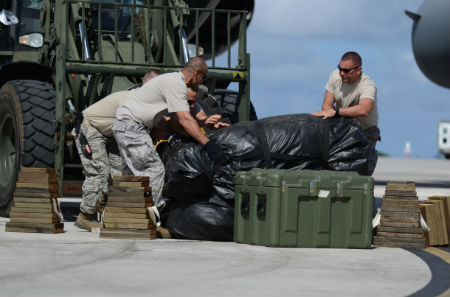 Pacific Air Forces assets continue to support relief operations in the Philippines after Typhoon Haiyan, but they will soon be winding down their activities, said PACAF Commander Gen. Hawk Carlisle at AFA’s Pacific Air & Space Symposium in Los Angeles on Nov. 21. After the storm’s Nov. 8 landfall on the island nation, US Pacific Command activated its humanitarian-assistance plan, which is built around forward-based marines and Navy assets on Okinawa, Japan, said Carlisle. PACAF prepared its 36th Contingency Response Group at Andersen AFB, Guam, which includes communications assets, runway repair capabilities, and RED HORSE engineers. “The biggest challenge is working through request processes,” he said, as PACOM was following direction from the State Department and US Agency for International Development. PACAF officials helped the Philippine armed forces with air-tasking manifests, as well as airlift operations. Special operations U-28 aircraft were called in, C-130s returning from an exercise in Bangladesh were diverted to Clark Field near Manila, and other assets flowed in once PACAF received requests from USAID. Carlisle anticipated that the two C-17s supporting the relief operations would return to their home station soon, as Philippine forces are taking over most of the follow-on operations. (See also AFSOC release on relief efforts)
Pacific Air Forces assets continue to support relief operations in the Philippines after Typhoon Haiyan, but they will soon be winding down their activities, said PACAF Commander Gen. Hawk Carlisle at AFA’s Pacific Air & Space Symposium in Los Angeles on Nov. 21. After the storm’s Nov. 8 landfall on the island nation, US Pacific Command activated its humanitarian-assistance plan, which is built around forward-based marines and Navy assets on Okinawa, Japan, said Carlisle. PACAF prepared its 36th Contingency Response Group at Andersen AFB, Guam, which includes communications assets, runway repair capabilities, and RED HORSE engineers. “The biggest challenge is working through request processes,” he said, as PACOM was following direction from the State Department and US Agency for International Development. PACAF officials helped the Philippine armed forces with air-tasking manifests, as well as airlift operations. Special operations U-28 aircraft were called in, C-130s returning from an exercise in Bangladesh were diverted to Clark Field near Manila, and other assets flowed in once PACAF received requests from USAID. Carlisle anticipated that the two C-17s supporting the relief operations would return to their home station soon, as Philippine forces are taking over most of the follow-on operations. (See also AFSOC release on relief efforts)
Why DARPA Thinks Stealth Is Obsolete in Future Wars
June 25, 2025
The stealth technology that gave the U.S. its airpower edge over the last 30 years is being overcome by new sensors that will make it hard for anything to hide, putting a premium again on speed and maneuverability, the deputy director of DARPA told AFA's Mitchell Institute for Aerospace Studies.